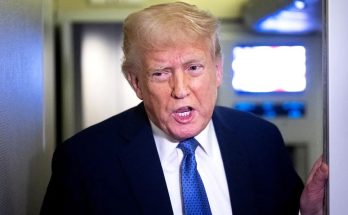
The president-elect won the battleground states of Pennsylvania, Georgia, North Carolina, and Wisconsin, while leading comfortably in Michigan and Nevada.
By the time Trump took the stage at the Palm Beach County Convention Center, Republicans had already captured the U.S. Senate with victories in Ohio and West Virginia. Further buttressing his mandate, the former president was also on track to win the national popular vote.
“This was a movement like nobody has ever seen before, and frankly, this was, I believe, the greatest political movement of all time. There’s never been anything like this in this country,” Trump said.
“We’re going to help our country heal. We have a country that needs help, and it needs help very badly. We’re going to fix our borders. We’re going to fix everything about our country.”
Earlier in the night, as Trump supporters gathered at his watch party in Florida, Cedric Richmond, co-chair of the Harris–Walz campaign took the stage in Washington, D.C., to inform the crowd that the vice president won’t be speaking that night.
“We still have votes to count. We still have states that haven’t been called yet,” Richmond said. “We want to fight to make sure that every vote is counted, that every voice has spoken, so you won’t hear from the vice president tonight.”
Exit polls by Edison Research showed Trump making significant gains with Hispanic Americans and younger voters.
As the Trump transition team prepares to take the White House, Americans can expect major changes in how the U.S. government handles foreign affairs, tax policy, and illegal immigration.
Trump promised to end the war in Ukraine before Inauguration Day and to launch the largest illegal immigrant deportation operation in U.S. history. As president, Trump will have the power to achieve both without the help of Congress. The same goes for rolling back the tailpipe emissions rule, which Republicans call a de-facto electric vehicle mandate.
The president-elect will have to work with Congress to deliver on some of his other promises, including ending taxes on tips, overtime pay, and Social Security income and expanding the child tax credit. Other provisions in his tax plan include reducing corporate taxes from 21 percent to 15 percent, maintaining lower individual taxes, and permanently expanding the $2,000 child tax credit.
On the campaign trail, Trump has floated the idea of ending taxation altogether and funding the government through tariffs on foreign goods. He has singled out China for 60 percent import tariffs and, a day before the general election, said he would threaten Mexico with a 25 percent tariff to get the southern neighbor’s help in stemming the flow of illegal immigrants.
The president-elect plans to tackle inflation by increasing American energy production, cutting wasteful government spending, and preventing illegal immigration. He has pledged to again exit the Paris Agreement on climate action, increase oil drilling on public lands, and offer tax breaks to oil, gas, and coal producers. He also discussed a comprehensive government reform initiative, seeking collaboration with Robert F. Kennedy Jr. to improve Americans’ health and with billionaire Elon Musk to reduce government waste.
Trump’s win makes him only the second president in American history to reclaim the office after losing his first bid for reelection. Grover Cleveland was the first president who won a second nonconsecutive term in 1892 after losing in 1888.
But the president-elect’s comeback story is perhaps unprecedented. During the final days of his term, and after leaving the White House in 2021, Trump was banned from several social media platforms, impeached for the second time by the House of Representatives, had his residence raided by federal agents, defended against several indictments on the state and federal levels, had his mugshot taken at a Georgia jail, and survived two assassination attempts. But despite the series of calamities, he ran a disciplined campaign, took control of the Republican National Committee, beat Republican fundraising records, and made gains with part of the electorate long-aligned with the Democrats.
Pollsters predicted a tight race leading up to Election Day. In the final weeks of the presidential campaign, Trump edged ahead of Harris in some battleground states.
While Trump was predicted to easily win the Sun Belt states—Georgia, North Carolina, and Arizona—his chances were considered lower in the so-called “blue wall” states of Wisconsin, Michigan, and Pennsylvania. He has made incremental gains in Nevada since 2016, and the state was up for grabs, based on polling averages on Nov. 5.
Polls showed that Harris had strong support from suburban women and voters with college degrees. Meanwhile, Trump had a significant advantage in rural areas and among non-college-educated white men. The Republican candidate gained support among younger voters, as well as black and Latino men.
In the final stretch of the campaign, Harris held a significant cash advantage over Trump, having outraised the Republican candidate nearly three-to-one in September and the first two weeks of October.
President Joe Biden and Harris raised $1 billion through the principal campaign committee currently known as Harris for President, according to records maintained by the Federal Election Commission (FEC). That figure covers all donations to the committee between Jan. 1, 2023, and Oct. 16, 2024.
Meanwhile, Trump’s principal campaign committee, Donald J. Trump for President 2024 Inc., raised about $388 million during the same timeframe, according to FEC data. Trump appears to have depended heavily on financial support from various super PACs.
According to research published by the political advertising tracking firm AdImpact on Nov. 4, about $1.6 billion overall was spent on the effort to elect a Democratic candidate. Most of that amount, about $1.3 billion, was used to support Harris. Ad spending to support Trump totaled $932.5 million and was spent in support of Trump.
Trump’s Path to the Nomination
More than a dozen Republicans challenged Trump for the party’s nomination.
To win the 2024 Republican nomination, Trump defeated more than a dozen notable adversaries—and he did it without participating in any of the four Republican presidential debates.
Trump declared his candidacy in November 2022. Several contenders jumped into the race early in 2023. But by the fall of last year, the field of candidates began to shrink. In October, Trump’s former vice president, Mike Pence, withdrew from the race. Sen. Tim Scott (R-S.C.) dropped out the following month.
Trump’s former ambassador to the United Nations, Nikki Haley, a former governor of South Carolina, hung on until March.
In 2016, Trump also defeated more than a dozen Republican presidential hopefuls. As a sitting president, he was unopposed in 2020.
From Trump Tower to the White House
Now 78 years old and making his third presidential run, Trump started his rise to fame and fortune in his native New York. After leaving the White House in 2021, he has lived in Florida, residing at his Mar-a-Lago estate in Palm Beach.
Following in the footsteps of his father, Fred Trump, he built an international real estate empire. Donald Trump became a household name during the 2000s while starring in the reality TV series “The Apprentice.” During the show, he coined his famous phrase, “You’re fired!” while axing a contestant at the end of each show. Trump also has authored several books, including “The Art of the Deal,” in 1987 that revealed principles that helped him negotiate business deals.
In 2014, Trump took steps toward running as governor of New York but decided against it. The following year, he pursued politics in earnest, ending years of speculation about a Trump presidential run.
Ever the showman, Trump launched his campaign in dramatic fashion. On June 16, 2015, he and his wife, Melania Trump, rode down a golden escalator at Trump Tower in Manhattan to announce his candidacy.
That day, he debuted his “Make America Great Again” slogan, echoing the “Let’s Make America Great Again” phrase that Republican Ronald Reagan used during his successful 1980 presidential campaign.
In 2016, Trump became the unlikely victor of the presidential election, making him the first U.S. president with no prior experience in public office or as a military commander.
Throughout the campaign season, polls showed Trump trailing Democrat Hillary Clinton, a longtime politician and wife of former President Bill Clinton.
During his presidency, Trump fought a barrage of political attacks that began immediately after he took the Oath of Office in 2017.
He became the third U.S. president to be impeached, and he stands alone as the sole president to be impeached twice. The Senate acquitted him both times.
During the first two years of his term, the president and dozens of people close to him were ensnared in the so-called Russian collusion inquiry headed by special counsel Robert Mueller. The special counsel concluded the investigation with a report that did not document any evidence of collusion. Meanwhile, the federal officials involved in investigating Trump were found to have pursued the Russia investigation largely based on a dossier of disinformation against Trump compiled by a former British spy whose work was being funded by the Clinton campaign.
In the final year of his presidency, Trump grappled with the COVID-19 pandemic as he campaigned for reelection. His Democratic opponent was Joe Biden, a longtime senator who served as vice president under President Barack Obama.
A Trump White House statement said his presidential accomplishments included a strong economy with low interest rates, “massive deregulation” to spur business growth, and taking “historic action to promote peace in the Middle East.” He was nominated for a Nobel Peace Prize for his efforts in the Middle East.
Trump and others disputed Biden being declared the winner of the 2020 election. Tens of thousands of Trump’s supporters, concerned about election irregularities, gathered in Washington on Jan. 6, 2021, to protest the impending certification of the election results. Some protesters breached the U.S. Capitol and skirmished with police.
Trump was born in New York on June 14, 1946; his parents, Fred Trump and the former Mary MacLeod, had five children. Trump himself has five children and is a grandfather of 10.
He received his education at the New York Military Academy, a private boarding school, followed by Fordham University and the Wharton School of Finance at the University of Pennsylvania, where he earned a bachelor’s degree in economics.


